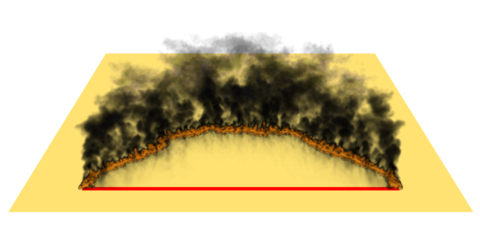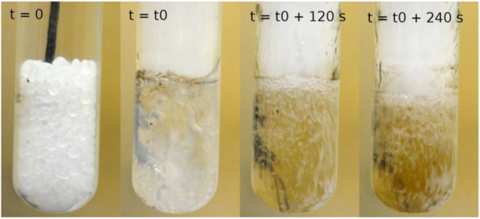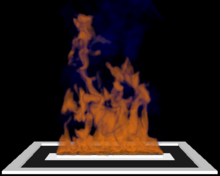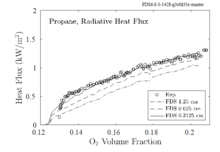Summary
The Fire Research Division develops and maintains a set of computational tools to analyze fire behavior. These tools include the Consolidated Fire and Smoke Transport (CFAST) zone model, the Fire Dynamics Simulator (FDS) computational fluid dynamics model, and Smokeview, which visualizes output from both CFAST and FDS. This research will extend the capabilities of these models, as well as improve their accuracy and reliability. More specifically, we will improve the prediction of burning rates for liquids and solid fuels in FDS. We will improve the prediction of toxic emissions (like carbon monoxide, hydrogen cyanide, and soot) and flame suppression in under-ventilated fires where toxic emissions are prevalent. We will also develop the capability within FDS to handle curvilinear flow obstructions. This will improve our ability to model flame spread and wind fields over complex surfaces (including wildland terrain and urban canopies). The ability to model complex geometry will also facilitate more accurate two-way coupling between FDS and finite-element models used for analysis of steel-constructed buildings. Our research includes work on modeling outdoor flows at the community scale; applications include the following: natural gas leak dispersion and inverse modeling, clean-up of marine oil spills, and flame spread at the wildland-urban interface (WUI).
Description
OBJECTIVE:
To develop and maintain robust, validated fire models—and the associated visualization and analysis tools—for
(1) performance-based design,
(2) forensics (fire reconstruction), and
(3) fire research applications in the built and natural environments.
TECHNICAL IDEA:
The development first of zone fire models, like the Consolidated Fire and Smoke Transport model (CFAST), and then high-fidelity, physics-based fire models, like the Fire Dynamics Simulator (FDS), has been driven by a need to better understand compartment fire dynamics for the purpose of protecting lives and property. CFAST and FDS continue to play a key role in performance-based design of buildings, saving billions of dollars annually in fire protection costs [1]. Consequently, these modeling capabilities must be maintained, with the simulation tools evolving to keep pace with changes in computing technology. At the same time, advanced fire models like FDS are facing new challenges.
Forensics:
Starting with the World Trade Center investigation [2], and later the investigations of the Charleston Sofa Super Store [3] and the Rhode Island Station Night Club [4] fires, the NIST Fire Dynamics Simulator has been used to reconstruct flame spread behavior and tenability conditions in burning structures. To date, investigators have relied heavily on full-scale testing to generate realistic heat release rate curves to be used in the model. But full-scale tests are both extremely expensive and sometimes simply impossible to perform for the desired conditions (consider zero gravity conditions in space, for example). Improving accuracy and reducing uncertainty in forensic analyses, therefore, requires an ability to predict large-scale heat release rates.
Roughly speaking, fire modeling can be broken down into two distinct (but coupled) problems: (1) pyrolysis, or the thermal degradation of the solid fuel into a volatile gas, and (2) the combustion of the volatile fuel, which generates the heat that feeds back to the solid. This feedback loop is highly nonlinear. Thus, while the fire modeling community has a handle on each problem separately, when the problems are coupled—as they are when predicting full-scale heat release rates—the output from the models is unreliable.
Improving reliability will require advancements in the prediction of local heat feedback to the surface of the solid, which is generally controlled by radiation. And since radiation is largely controlled by local soot concentration and temperature, we will require improvements to local soot emissions prediction. In the solid phase we will require improvements to our ability to measure the appropriate material thermal and kinetics properties. We will also require improvements to our ability to account for the complexity of material geometry. For example, fire resistant coatings often intumesce, or swell, as a way of slowing the heat transfer to the burning solid. Additional complexities in the solid phase include melting, which can form secondary pool fires, and volatile transport in porous media. Neither of these phenomena are present in the current FDS solid phase model.
Outdoor flows:
FDS was originally designed to model simple plumes and compartment fires where external boundary conditions are well defined. Over the past decade, however, FDS has been thrust into the role of modeling wildland-urban interface (WUI) fires [5] and pollutant dispersion at the community scale [6]. In these outdoor flows, the external boundary conditions are continuously varying in both space and time. To further complicate matters, for a given problem we rarely know precisely what the boundary conditions are—we must rely on estimates of mean winds and turbulence intensity. These estimates may be obtained from data stations inside the domain or from larger-scale simulations. In either case, the external boundary conditions are not supplied—the internal data must be assimilated into the FDS calculation.
While FDS has made modest progress in modeling outdoor flows at the community scale, several research questions remain. The principal issue is in how the wind field data is to be assimilated into the FDS calculation. FDS currently uses a form of data assimilation called nudging, which forces the mean wind field to track toward a specified target value—the specific value, as mentioned, comes either from measurements or a larger-scale weather model. The research questions for data assimilation are: how do the parameters of the nudging model (for example, the relaxation time scale, assimilation target) affect the global solution and how are boundary effects with complex terrain to be minimized.
In most outdoor flows the terrain is not a perfectly flat surface. In fact, most of the interesting—and potentially dangerous—wildfire flow situations involve slopes and canyons. So, in addition to challenges with external boundary conditions, FDS inherits the challenges that come with modeling flows over complex geometry. These issues are being studied in the context of complexities in compartment fire dynamics (see previous discussion on forensics), but atmospheric boundary layer flows have an added challenge in that the dynamics is dramatically affected by the global state of stability of the boundary layer (stable, neutral, unstable). And since the problems of interest for atmospheric flows involve time scales that span hours or days, FDS must be capable of handling the effects of the diurnal cycle, including variation in surface heating (night vs. daytime) and atmospheric moisture (humidity and clouds).

Figure 1: FDS simulation of CSIRO Grassland Fires
Modeling flame spread in wildland fires and WUI fires must also involve the modeling of ember transport. It has been well-documented [7] that spot fires from embers are a dominate flame spread mechanism in wildfires. Further, WUI fires may spread by embers that come from burning homes as well as vegetation. FDS has the capability to transport embers as Lagrangian particles. These particles obey specified drag and heat transfer laws and may be linked to material properties that allow the embers to burn as they are transported. The primary research focus from a modeling point of view is verification and validation of the current modeling capabilities.
Flame Spread on Complex Materials:

The fire community has made considerable progress on measurement of macroscopic material properties and kinetics constants for “simple” materials. The most commonly studied material is a clear plastic known as PMMA (poly methyl-methacrylate). One of the reasons PMMA is popular with researchers is that it does not form a char, which simplifies the kinetics to a single one-step reaction. Additionally, PMMA does not intumesce (swell or expand) upon heating, so the geometry stays simple under controlled laboratory conditions. But even PMMA can melt and create a pool fire, thus changing the global heat release rate and altering the thermal feedback cycle in unpredictable ways. In real fires, even this simple melting problem renders the current FDS mathematical framework useless. Further, upon heating in a fire most common materials form char, foams, or add other levels of geometric complexity that make it impossible to translate bench scale physical property measurement to real-world application. Figure 2 shows the pyrolysis of polyethylene forming liquid and bubbles, which significantly impact the “effective” thermal properties of the material.
The immediate research need is to establish a baseline set of validation cases for the spread of fire over PMMA and similar polymers, pulling from experiments in the existing literature [8]. It has been demonstrated that FDS is capable of predicting the burning rate of these materials in devices such as the cone calorimeter.
In parallel with work to characterize complex solids is work to improve the prediction of radiation heat flux from fires impinging on surfaces. There are several examples of these fire scenarios in the current validation guide, but the accuracy of the model depends on a variety of factors, including the geometry, fuel type, and radiative properties of the fuel and exhaust products.
Data Visualization:
In an effort to help fire fighter training and to gain insights into evacuation and compartment fire phenomena, we have begun work on 3D visualization of fire within Smokeview. At present, 3D videos may be generated from a single viewpoint within an FDS simulation domain. In the future, we will add the capability to view 3D video from a tour within Smokeview. The next step for full virtual reality (VR) with real fire physics would be to allow real-time translation of the viewpoint position controlled by the VR headset movement. And the final step would be to couple with an interactive fire scene, where, for example, the user could open a door or window, or throw water on the fire. The first step is underway, and we are looking toward a collaboration with the VR group at NIST in Boulder, CO, to finalize this phase of the project. The next two steps (tours and translation) are a two-year effort. And the final step would be a three-year project on its own, as it would require significant research on the FDS modeling side to provide real-time simulation updates.
We are also undertaking an effort to improve data visualization for extremely large simulations that are necessary in Large Outdoor Fire Models (LOFM). Smokeview will be upgraded to run in parallel on a computer server, while data visualization will be done on a convenient web interface, which can then be viewed or controlled from an smart phone application as well as a computer terminal.
RESEARCH PLAN:
In addition to general support for the public release of both FDS and CFAST, the project is separated into 10 research tasks, all of which are critical to the project’s objective. Tasks 1-7 are FDS and Smokeview development. Tasks 8 and 9 are experiments for FDS validation. And Task 10 is CFAST maintenance.
Task 1 Complex Geometry in FDS:
In previous years, we have developed a cutcell-immersed boundary (CC-IBM) method to handle complex geometry in FDS. The present task is to finalize the implementation in the FDS code trunk and to hook up all the boundary conditions, output options, and special features available to users in the baseline Cartesian code. This will include modification of the radiation solver to correctly treat surfaces with arbitrary orientation.
Task 2 High-end Visualization in Smokeview:
The introduction of non-Cartesian geometry into FDS has necessitated an overhaul of the way Smokeview draws geometry. Further work is needed to support boundary files and slice files around complex geometry. It is critical that the visualization is a seamless transition for the user. In addition to complex geometry, FDS is continuously pushing the limits of computing power and generating ever larger datasets to be visualized. Smokeview is under continuous development to keep pace with these large data visualization needs. And as more outdoor flows are modeled, there is more and more a need for Smokeview to provide better ways to visualize wind data and to show terrain texture maps to better identify the community landmarks.
Task 3 Flame Spread on Simple Materials:
In this task, we will capture recent work on modeling flame spread over PMMA and other materials into the FDS Validation Guide. Experiments are to be conducted in the National Fire Laboratory in an apparatus consisting of 2.4 m tall, 0.6 m wide panels separated by 0.3 m with a propane burner as igniter. Thermo-physical parameters of the materials shall all be measured directly. In this way, we test whether the model can be used to truly predict the spread rate of fire over simple materials.
Task 4 Carbon Monoxide (CO) Prediction with Flame Suppression:
We continue our work on verification and validation of carbon monoxide (CO) prediction in FDS. Most fire deaths are attributed to CO poisoning. This task is aimed at significantly improving the accuracy and reliable of CO prediction, which is critical to effective use of these models for predicting and recreating fire scenarios. The chemistry sub-model in FDS has been generalized to handle detailed chemical mechanisms. The present task is to develop an extinction model capable of handling multiple fast reactions. The goal is to implement both the multi-step CO mechanism and the multi-step extinction model as the default reaction scheme for all CO cases in the FDS validation suite, from small scale (Smyth burner) to a full-scale compartment (NIST Full-Scale Experiments).
Task 5 Development of an Improved Local Radiant Fraction Model:
By default, FDS applies a correction factor to the emission term in the radiation transport equation in an attempt to force the global radiant fraction to integrate to a predefined value. Since the convective heat release dominates the plume dynamics, it is critical that FDS gets the global radiant fraction correct. It is particularly challenging to design a method that properly handles both simple plumes and under-ventilated compartment fires. Fig. 3 shows results for a multi-step reaction mechanism with CO and soot as intermediates. The correct radiative flux is achieved as the grid is refined.

|

|
Figure 3: (Left) Visualization of soot volume fraction (orange) and CO2 (blue) for the UMD line burner propane flame. (Right) Radiative fraction versus experiment for three grid resolutions.
Task 6 Development of a Global Pressure Solver:
One of the limitations of the FDS pressure solver is that it only operates on a single mesh or domain block assigned to one processor of a distributed memory parallel computer (super-computer). While the discrete FFT algorithm is nearly optimal for use in solving the pressure Poisson equation on a single mesh, extending this algorithm to parallel computing is not trivial. However, PFFT solvers have been successfully implemented in other codes and would eliminate mesh-to-mesh velocity errors for simple block domains that usually used in outdoor flows.
Task 7 Wildland Fire Spread Validation:
There is presently an effort to merge back the functionality of the Wildland Fire Dynamics Simulator (WFDS) into the latest FDS trunk. Over the past year, several simple verification tests for drag and mass loss rates from subgrid Lagrangian particles—which represent vegetation in the model—have been implemented into the FDS V&V suite. We will continue to add to the V&V suite and develop the input hooks and modifications to the FDS pyrolysis model needed to accommodate the multi-step kinetics used for evaporation, burning, and char oxidation in the WFDS vegetation model.
Task 8 Experimental Support for Measurement and Computation of Fire Phenomena (MaCFP):
The FDS development team is involved in a community effort to improve physics-based computational models and modeling practice. The effort is called the working group on Measurement and Computation of Fire Phenomena, or MaCFP. We will contribute data for burning rates of liquid pool fires (methanol, ethanol, etc.) with detailed heat flux measurements. We will add measurements of major stable species within the flame envelope for 30 cm and 1 m pool fires and water-cooled gas burners with a range for fuels.
Task 9 Controlled Vegetation Drag, Heat Transfer, and Flame Spread Measurements:
In FDS vegetation is modeled using subgrid Lagrangian particles. These particles interact with the gas phase flow solver by imparting drag and exchanging heat---via convection and radiation---and mass. The irregularity of the vegetation shapes combined with the structural flexibility and heterogeneous material properties make it very difficult to use simple correlations for heat and mass transfer on vegetation. Further, we have experience to indicate that the overall spread rates produced by the models are extremely sensitive to the drag, heat and mass transfer formulas.
Task 10 Improved Radiation and Tenability in CFAST:
This task is to add improved accuracy and functionality to the CFAST model. CFAST is a two-zone fire model used to calculate the evolving distribution of smoke, fire gases and temperature throughout compartments of a building during a fire. CFAST is a vital design tool for the engineering community because its calculations can be run in minutes as opposed to hours or days for FDS. Over the last couple years, CFAST has been updated to be in compliance with modern Fortran standards and combustion chemistry that is more consistent with FDS. This task is to improve the computation of radiation view factors to targets in CFAST, beginning with a suite of verification and validation cases that can be used to test any proposed improvements to the model. In addition, the task will add calculation of tenability consistent with ISO standards 13571 using existing outputs from the CFAST model.
REFERENCES
[1] J.R. Hall. The total cost of fire in the United States. National Fire Protection Association, March 2014.
[2] S.S. Sunder. NIST NCSTAR 1: Federal Building and Fire Safety Investigation of the World Trade Center Disaster. September 2005.
[3] N.P. Bryner, S.P. Fuss, B.W.Klein, A.D. Purtorti. Technical Study of the Sofa Super Store Fire – South Carolina, June 18, 2007. NIST-SP 1118 Vols 1 and 2, March 2011.
[4] W. Grosshandler, N. Bryner, D. Madrzykowski, K. Kuntz. Report of the Technical Investigation of The Station Nightclub Fire. NIST NCSTAR 2: Vols 1 and 2, June 2005.
[5] A. Maraghides, D. McNamara, W. Mell, J. Trook, and B. Toman. A Case Study of a Community Affected by the Witch and Guiejito Fires: Report #2 – Evaluating the Effects of Hazard Mitigation Actions on Structure Ignitions. NIST Technical Note 1796, 2013.
[6] K. Prasad, A. Pintar, H. Hu, I. Lopez-Coto, D. Ngo, J. Whetstone. Greenhouse Gas Emissions and Dispersion: Reducing Uncertainty in Estimating Source Strength and Location through Plume Inverse Models. NIST SP 1175, 2015.
[7] S. Manzello, T. Cleary, J. Yang. Urban/Wildland Fires: Ignition by Embers. Interflam, 2004.
[8] A. Ito, T. Kashiwagi. Characterization of Flame Spread over PMMA Using Holographic Interferometry Sample Orientation Effects. Combustion and Flame, 71:189-204, 1988
.
Major Accomplishments
Software
- Fire Dynamics Simulator (FDS) is a large-eddy simulation (LES) code for low-speed flows, with an emphasis on smoke and heat transport from fires. Smokeview (SMV) is a visualization program used to display the output of FDS and CFAST simulations.
- CFAST is a two-zone fire model capable of predicting the environment in a multi-compartment structure subjected to a fire. It calculates the time-evolving distribution of smoke and gaseous combustion products as well as the temperature throughout a building during a user-prescribed fire.

